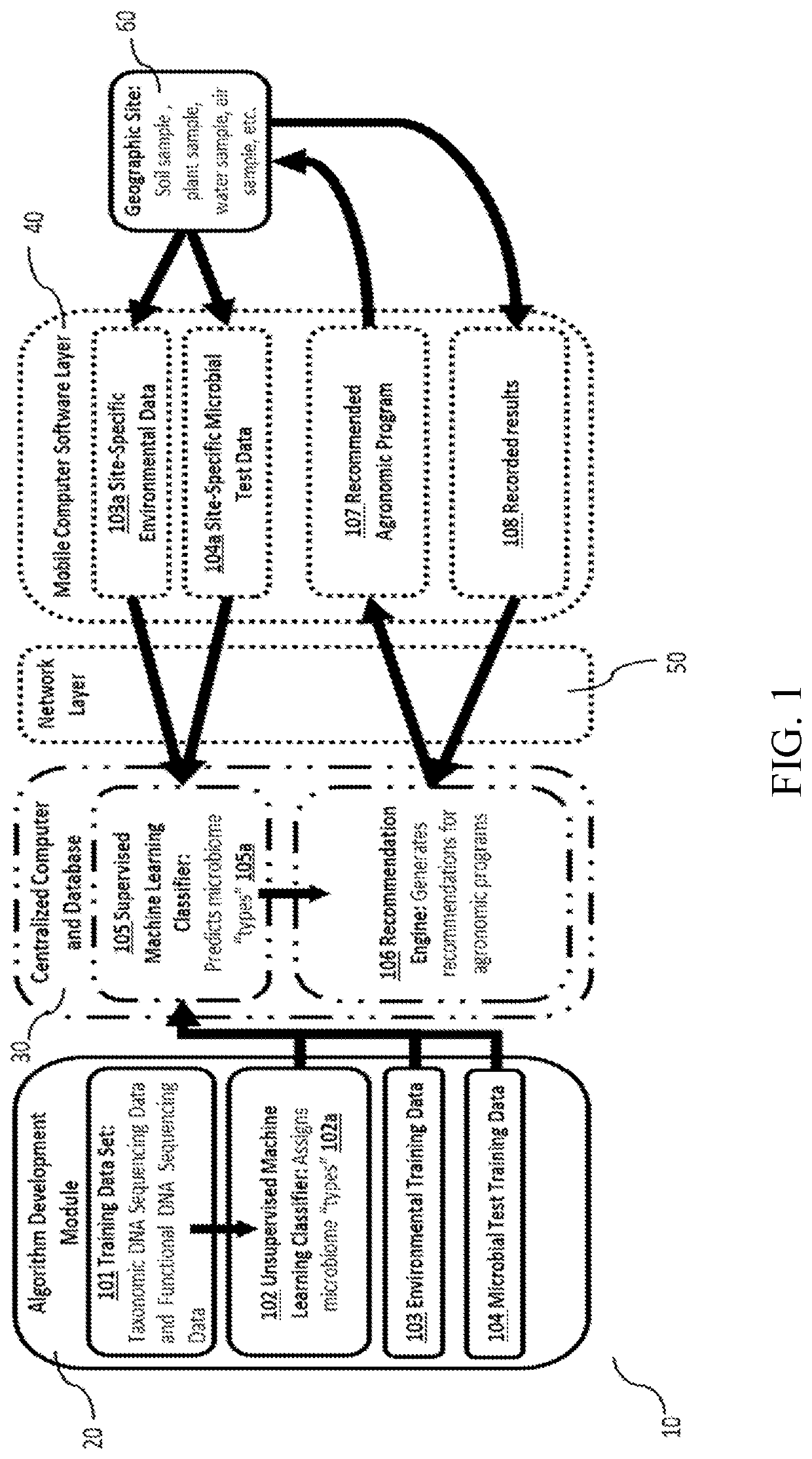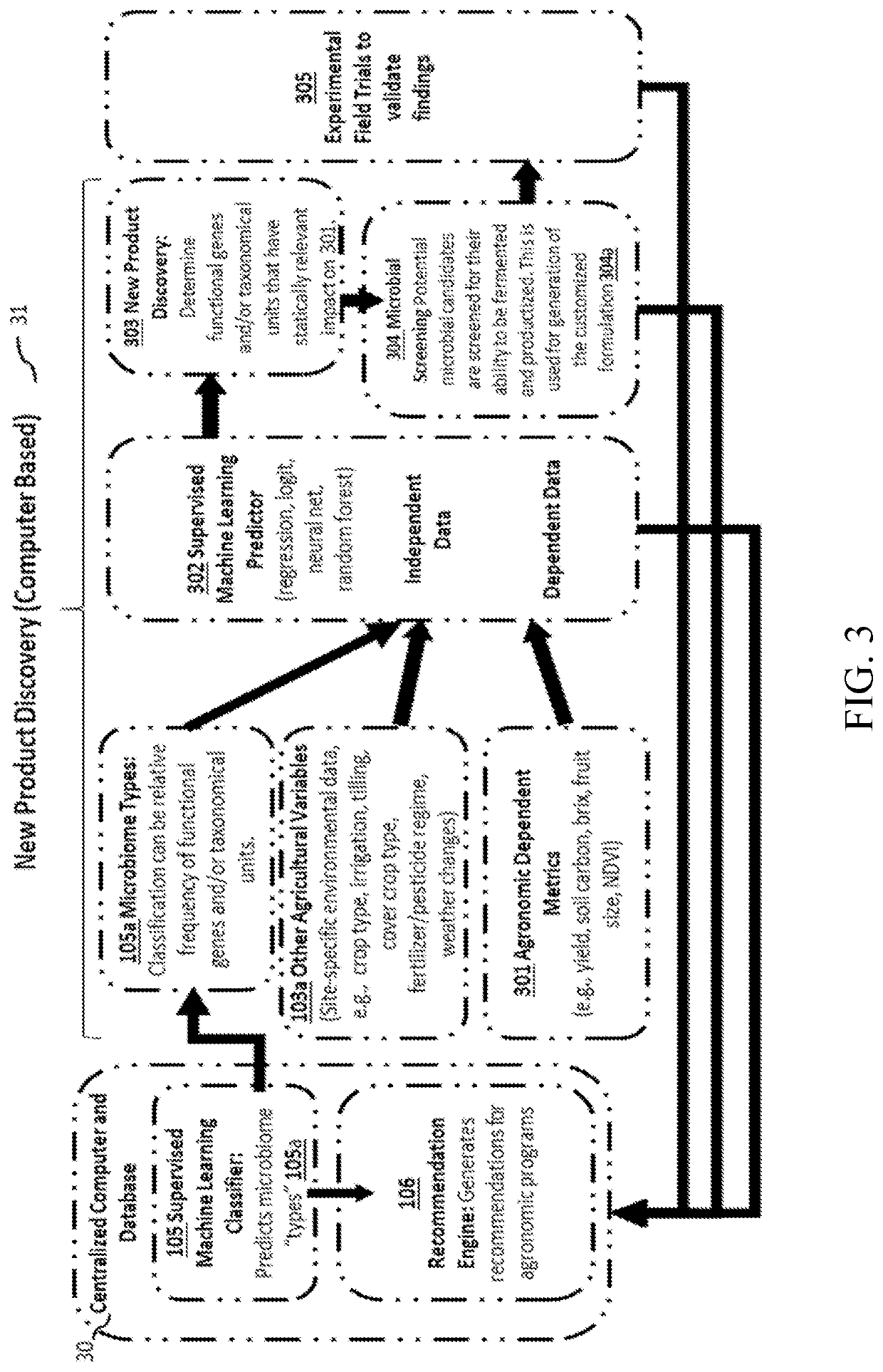Use of soil and other environmental data to recommend customized agronomic programs
a technology of agronomic programs and environmental data, applied in agriculture tools and machines, instruments, computing models, etc., can solve the problems of difficult to produce locally-adapted recommendations, complicated discovery of optimal application parameters of these types of products, and inability to culture microorganisms in environmental samples, etc., to improve the recommendation capabilities of the system, improve the effect of cost-effective and efficien
- Summary
- Abstract
- Description
- Claims
- Application Information
AI Technical Summary
Benefits of technology
Problems solved by technology
Method used
Image
Examples
example 1
Generated Recommendation for Agronomic Programs Using Soil Samples
[0289]Aspects of FIG. 1 and FIG. 3 are referenced in this Example. The Algorithm Development (AD) module 20 receives a Training Data Set 101 comprising DNA sequencing data derived from soil samples (not shown) taken from a plurality of geographic sites. The Training Data Set 101 provides a relative frequency of taxonomic-indicating and / or function-indicating gene markers within the tested soil samples, thereby providing a relative frequency of soil microbial species and / or gene functions in each sample.
[0290]The Unsupervised Machine Learning Classifier (UMLC) 102 analyzes the Training Data Set 101 and classifies each soil sample by microbiome “type”102a based upon similarities between the samples. The similarities can include relative frequencies of taxonomical units, functional gene sequences, or other information derived from the DNA sequencing data of the Training Data Set 101.
[0291]Other agronomic training data is...
example 2
ing Microbial Test Data
[0296]Aspects of FIG. 2, which depicts a block / flow diagram of methods for obtaining microbial test data 41, are referenced in this Example. The microbial test data 104, 104a comprises quantitative measurements of microorganisms, including population numbers and / or proportions, as well as gene function frequencies, in a sample.
[0297]Field-based assays are one method for obtaining quantitative data regarding microbial species, gene markers, and / or gene functions present in a sample. A paper-based field assay 42 involves a chemical label (e.g., a dye, fluorescing agent, up-converting phosphor particles (UCPs)) 205 that produces a signal (e.g., color change, fluorescence or luminescence) 205a based on the concentration of a target analyte (e.g., DNA, protein, antibody or microbe) in a sample (e.g., soil). The label 205 and the sample are applied to a paper component so that they can contact one another to produce the signal 205a.
[0298]Two forms of paper-based fi...
example 3
nt of Recommendation Engine for New Product Discovery
[0302]Aspects of FIG. 1 and FIG. 3 are referred to in this Example. The Recommendation Engine 106 is used to generate recommendations for agronomic programs 107. The agronomic program 107 can include a customized formulation for a new product, or soil and / or crop treatment composition, for applying to a geographic site 60.
[0303]A Supervised Machine Learning Predictor (“SMLP”) 302 receives, as input data, predicted microbiome type classification 105a, site-specific environmental data 103a, and an agronomic metric of interest (e.g., yield, soil carbon sequestration, brix value, fruit size, NDVI, etc.) 301 for a specific geographic site 60; and identifies the statistically impactful relationships between the predicted classification 105a and / or site-specific environmental data 103a, and the agronomic metric 301.
[0304]The SMLP 302 produces as output, the identities of key predicted microbiome classifications 105a and in turn, identifi...
PUM
| Property | Measurement | Unit |
|---|---|---|
| storage time | aaaaa | aaaaa |
| storage time | aaaaa | aaaaa |
| storage time | aaaaa | aaaaa |
Abstract
Description
Claims
Application Information
 Login to View More
Login to View More - R&D
- Intellectual Property
- Life Sciences
- Materials
- Tech Scout
- Unparalleled Data Quality
- Higher Quality Content
- 60% Fewer Hallucinations
Browse by: Latest US Patents, China's latest patents, Technical Efficacy Thesaurus, Application Domain, Technology Topic, Popular Technical Reports.
© 2025 PatSnap. All rights reserved.Legal|Privacy policy|Modern Slavery Act Transparency Statement|Sitemap|About US| Contact US: help@patsnap.com



